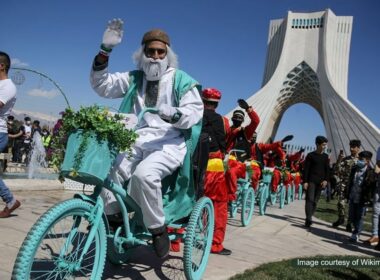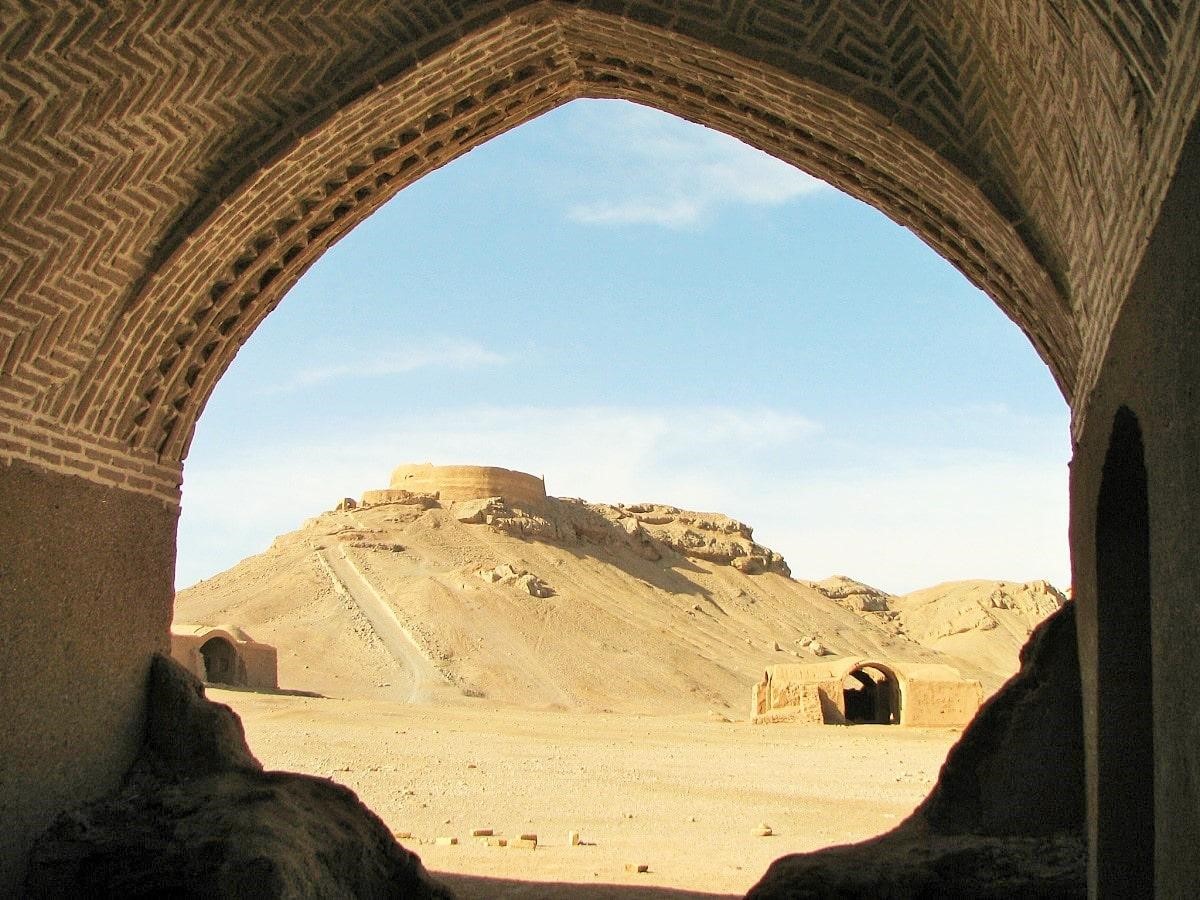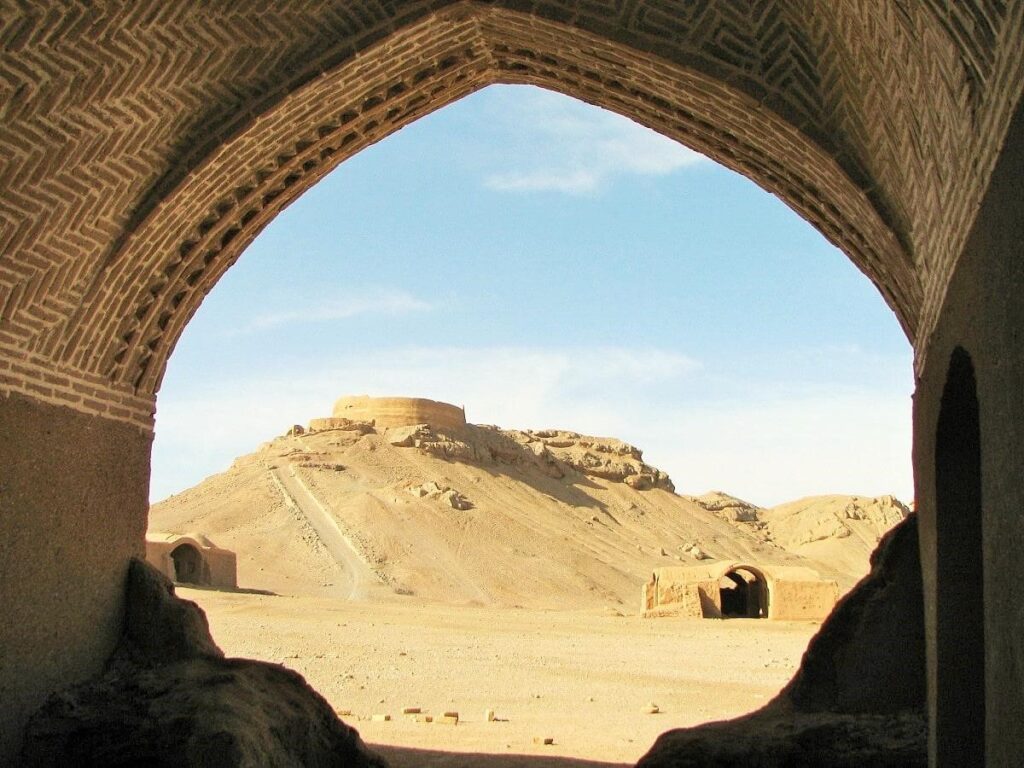
Yazd City is one of the largest cities in Iran located in the center of the Iranian plateau. After Bam City in Kerman, Yazd was the second city that was registered with UNESCO because of its untouched traditional architecture. There are many historical sites in this beautiful city, and the Yazd Tower of Silence or Dakhmeh-ye Zartoshtian (Zoroastrian Dakhma) is one of them. This tomb was added to the Iran National Heritage List in 2002.
Zoroastrian dakhmas are also known as the Towers of the Silent or Towers of Silence. These historical monuments are located 15 kilometers southeast of Yazd and around the Safaeih area. The dakhmas are located on top of a low mountain called “Kuh Dakhmeh”.
The History and Purpose of Yazd Zoroastrian Dakhmas
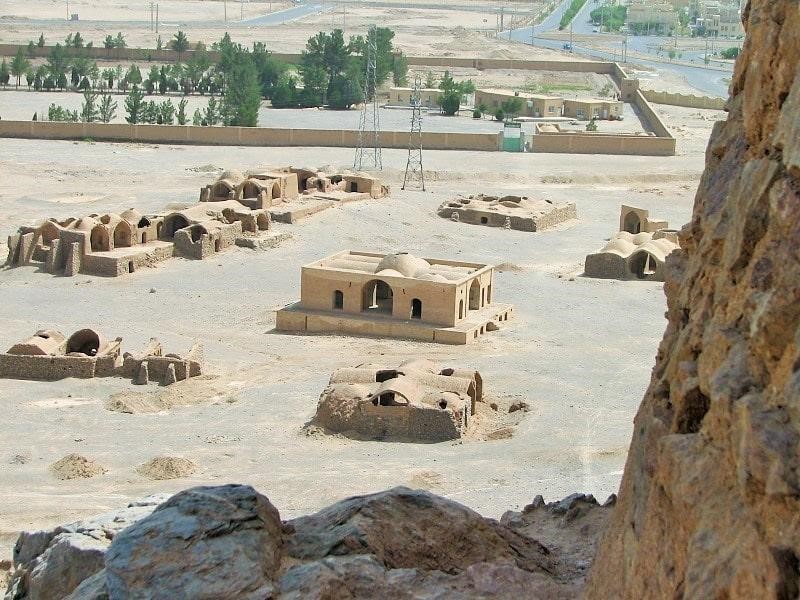
Dakhmas are structures built using raw clay that are sometimes even formed by natural phenomena. These buildings had many applications in the past. For example, Zoroastrians placed the bodies of their deceased in these buildings so that carrion birds would consume their flesh. Then, in a special ritual, their remaining bones were placed in a pit in the middle of the dakhma.
They believed that decomposing dead bodies should not pollute the four main elements (water, soil, fire, and wind). These elements are very sacred in Zoroastrian beliefs. Therefore, they were opposed to burying the dead in the ground. In addition, Zoroastrian beliefs do not recommend mourning and crying when a loved one dies and forbid their followers from such practices.
Over time and with the development of the Zoroastrian religion, there were changes in the architecture of the Zoroastrian towers of silence or dakhmas. For example, they began to use stones as construction material instead of clay to not use soil as the main material. Also, the dakhmas were built on high ground to prevent the access of land animals. Thus, the flesh of the deceased was only consumed by carrion birds such as vultures.
During the Pahlavi era and with the expansion of cities and changes in water supply infrastructure and other modern developments, Zoroastrians also stopped this custom while maintaining their belief and principles of preserving the four sacred elements of nature. By burying the bodies in cement graves, they still prevent the absorption of decomposed materials into the soil or groundwater. Therefore, the Yazd Towers of Silence, like other historical dakhmas in Iran, have lost their previous application.
The Construction Process of the Zoroastrian Towers of Silence (Zoroastrian dakhmas)
The construction of the Zoroastrian dakhmas was accompanied by a unique ceremony. Zoroastrians followed this procedure to build their sacred dakhmas:
- Before building the dakhmas, 4 large nails, 36 medium nails, and 260 small nails were hammered into the ground. Every time they hit the nail on the ground, they would recite “Yatha Ahu” (a mantra, the opening words to Ahuna Vairya).
- They used to bind a hundred cotton threads together and make a rope with it.
- The rope was wrapped around the nails three times.
- Then they would sit in the place of the tomb and recite 100 “Ashem Vohu” and 200 “Yatha Ahu” and throw 300 small stones to the area of construction of the dakhmas.
- Finally, the dakhmas were built on the sacred ground.
Design Features and Architectural Style of Yazd Zoroastrian Dakhmas
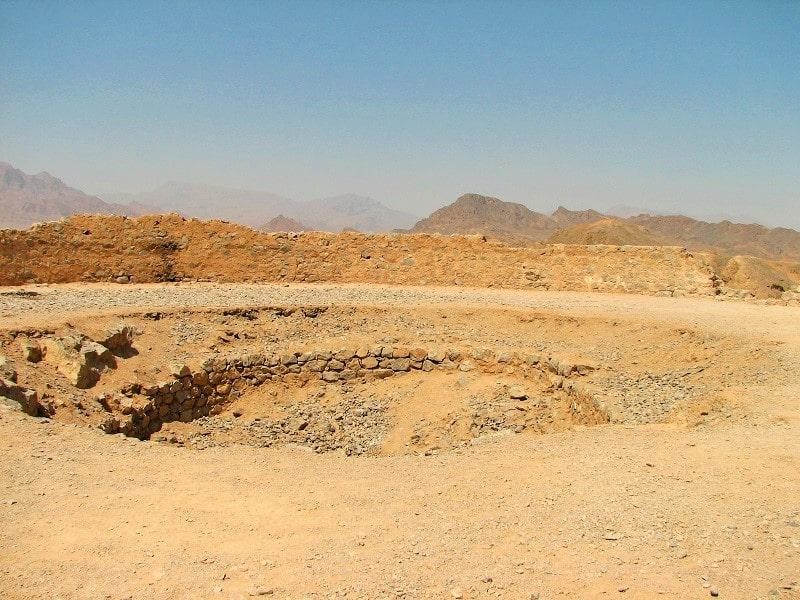
These dakhmas are two round stone buildings named “Maneckji Limji Hataria” and “Golestan” located on top of a low mountain. The Maneckji dakhma was built during the time of Naseruddin Shah, it is on the left side of the mountain with a diameter of about 15 meters. The builder of this dakhma (Maneckji) was one of the Zoroastrian Persians originally from India, who was a civil rights activist.
During the time of Naser al-Din Shah Qajar, he came to Iran to represent the “Persian Zoroastrian Amelioration Fund” and improve the status of Zoroastrians in Iran. Maneckji was considered one of the most influential people in Zoroastrian society and is still remembered fondly by Zoroastrians. He died in 1890 in Tehran and his body was laid to rest in Maneckji dakhma.
During the Qajar period, since reaching Maneckji’s dakhma was very challenging, another dakhma was built nearby. This dakhma, Golestan, is located 150 meters from Maneckji Dakhma. The dimensions of the Golestan dakhma is smaller than Maneckji and its diameter and height are 25 and 6 meters respectively.
The Zoroastrian Towers of Silence were built in a circular shape and covered with stone slabs. In the middle of the dakhma , there is a pit for throwing corpses, which is called “Astodan”. At the end of this pit, there is a stone called Ervis.
The bodies of women, men, and children were placed in different parts of this dakhma . The reason for this should be found in the geometrical principles related to the circle and size of the bodies. The dakhma includes the outer, middle, and inner belts, where men’s bodies were placed in the outer belt and near the wall, and women’s bodies were placed in the middle belt. The inner belt was located near the pit, holding the bodies of the children.
There are other buildings near the Yazd Towers of Silence called Khileh. These buildings are made of clay and are located on the northern side of the mountain. They date back to the Safavid period.
After placing the bodies inside the dakhmas, Zoroastrians entered the Khileh to perform their religious ceremonies. All of them wore white clothes during the ceremony.
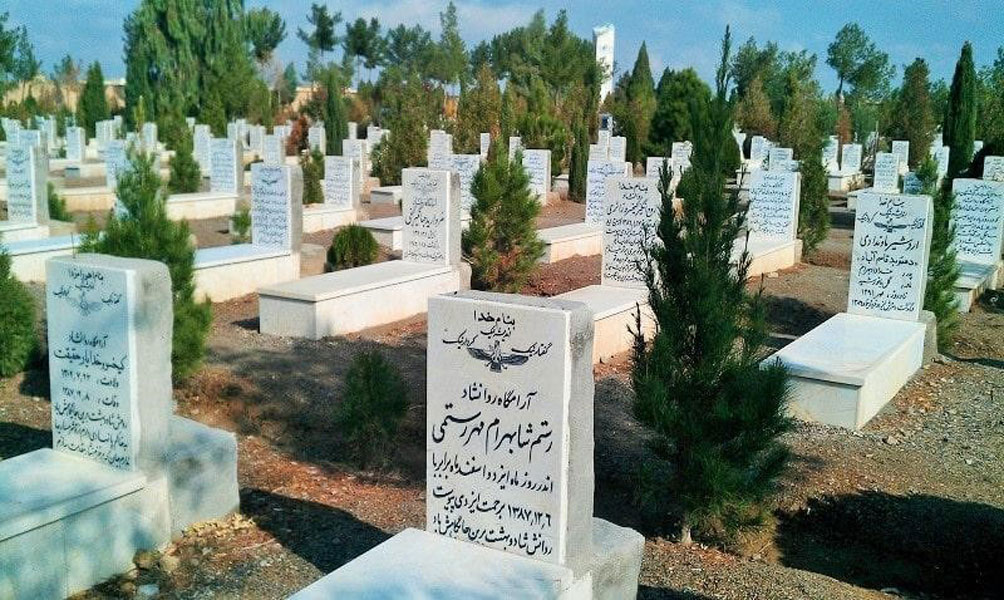
Today, this ceremony and this style of saying farewell to the dead bodies of loved ones is no longer practiced among Zoroastrians. Instead, they bury the bodies of their deceased in insulated graves. The reason for this is adherence to the principles of preserving the four sacred elements of nature. The modern Zoroastrian Cemetery of Yazd is located next to the Zoroastrian dakhmas of Yazd.
What Does Nesa Mean and Who is Nesakesh?
In the past, the bodies of the dead were called Nesa, and a person called Nesakesh carried them to the dakhmas. Inside the dakhma, there was a person who was bound to remain inside for the rest of their life and was responsible for receiving the bodies from the Nesakesh. The person in charge of the dakhma took the corpses from the Nesakesh and placed them inside the dakhma .
He would wait for the birds to eat the flesh of the corpses. Then, he would place their bones in the pit in the middle of the dakhma.
You can look at the following research and learn more about the rituals of Zoroastrian Dakhmagozari Rituals.
Visit the Mystical Yazd Towers of Silence
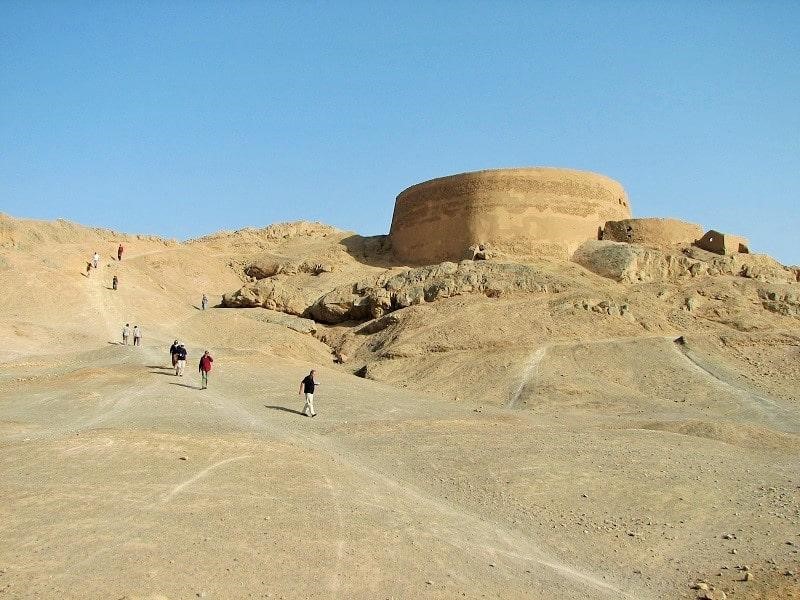
Yazd is an ancient city with many historical monuments. The Yazd Towers of Silence or Zoroastrian akhmas is one of the historical monuments that attract many tourists every year.
If you travel to Yazd on an Iran tour package or personally, don’t miss visiting this dakhma. Destination Iran invites you to visit the Zoroastrian Dakhmas, one of the most interesting Yazd tourist attractions.
Where is Yazd Towers of Silence (Dakhma-ye Zartoshtian)?
The Zoroastrian Tower of Silence is located 15 kilometers southeast of Yazd city, near the Safaieh area. This place is located on top of a low mountain called “Dakhmeh”. You can see the exact location of this dakhma below:
Frequently Asked Questions About Zoroastrian Dakhma-ye of Yazd
If you cannot find the answer to your question here, leave us a comment in the comment section below this post and ask your question. We will answer it as soon as possible.
What are the other names of the Zoroastrian Dakhmas?
Zoroastrian dakhma of Yazd is also known as the “Towers of the Silent” and “Towers of Silence”.
What are the design features and architectural style of the Yazd Zoroastrian Dakhmas?
Zoroastrian Dakhmas of Yazd are built in the form of two round stone buildings with the names “Maneckji Limchi Hatria” and “Golestan”, and are located on top of a low mountain. The dakhmas are built in a circular shape and the dimensions of the Golestan dakhma are smaller than the Maneckji Dakhma.
All around the dakhmas are covered with stone slabs and in the middle of the dakhma, there is a pit for placing the corpses, which is called “Astodan”.
When is the best time to visit the Yazd Towers of Silence?
Since these tombs are located in a desert region, the best time to visit this ancient monument is from early March to early June.
Is the Yazd Towers of Silence on the Iran National Heritage List?
These dakhmas were registered among the national monuments of Iran in 2002.
How old is the Yazd Zoroastrian Dakhmas?
The tomb of Maneckji Limchi Hatria was built during the time of Naseruddin Shah Qajar. The Golestan dakhma was built later, during the Qajar era and after the Maneckji Dakhma.



